France, Part II
We returned to France after two days in Spain. It was nice to return to somewhere kinda familiar, although at first I kept saying "si" instead of "oui" and wanting to say "Hola" instead of "Bonjour".
Our first day was a long, long drive through the wine producing provinces of Roussillon (sp?) and Languedoc, to Nimes, almost on the border of Provence. Everywhere we went, as far as the eye could see, were nothing but vineyards. Being still spring there weren't any leaves on the vines yet, let alone grapes.
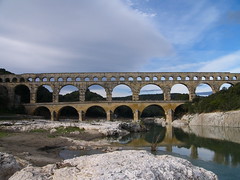
We stayed in the small town of Remoulin, just east of Nimes, and right next to the Pont du Gard, an amazingly well preserved, totally intact, three level Roman aqueduct spanning the river Gard. For free we were able to walk right up to it, touch it, walk around it, view it from every angle, do everything but walk across the top.
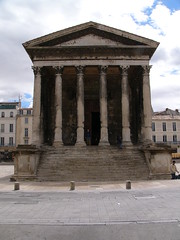
In Nimes we saw an old Roman colosseum which is still used for sporting events to this day, and an ancient Roman temple (now called the Maison Caree - square house) which is also perfectly preserved due to having been continuously used throughout the centuries.
From Remoulin we travelled through Provence (wrong time of year for the lavender fields I was hoping to see, but we did see lots of cherry (?) trees in bloom, to the Cote d'Azure. This was just a one night stopover before heading on to Italy.
I've been to the Cote d'Azure once before. After nearly two months of backpacking on my own I really needed a break, and spent a wonderful day lying on the beach in the sun in Cannes. On that occasion I travelled by train and it really was stress-free. This time however we arrived during evening "rush" hour, and it took us 45 minutes to travel just eight kilometres.
The Cote d'Azure is great if you want to spend a week on the beach. But if you're just passing through it's a bit of a nightmare. We stayed at Cagnes-sur-Mer, in a campground just out the back of the industrial part of town, in a deep valley that gets no sun. I guess land prices are so expensive here that you don't want to go wasting the good stuff on camping.
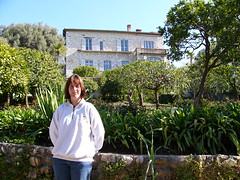
One hidden treasure we did find in Cagnes-sur-Mer was the house that Renoir (my favourite artist) had built, and where he lived and worked for the last 11 or 12 years of his life. It has now been turned into a museum dedicated to the artist. Really incredible to see his actual studio and to learn a bit about his life.
And then our trip through France came to an end, battling traffic to get to the Italian border. I've really enjoyed France - good food, nice people, lots to see and do. We've covered the whole range of French history - from prehistoric in the Dordogne, to Roman in Nimes, to Renaissance and Monarchy in the Loire, to 19th Century art in Paris & Cagnes, to modern life. Everything's been relatively easy and uncrowded, although less so as we've headed towards Italy and Easter. There are German tourists everywhere at the moment.
We'll be back to France in two and a half weeks time, if only to fly out of Paris and back to London. Doesn't sound like much time, but we've got a lot of things planned to do. Just hope we can fit it all in.
Barcelona, Spain
Peter and I spent a day and a half in Barcelona. What an expensive place. 48 hours in total in Spain and we spent the equivalent of what we'd spent the previous week travelling round rural France.
However there are some disclaimers to go with this remark, and at least some of this expenditure was of our own choosing. After all, here we were in one of Europe's largest cities, on a Saturday night. So we did what every Antipodean traveller needs to do at least once - go out drinking.
So expense No 1 was an inner city hostel/pensione so that we could stumble home in the wee small hours. 60 Euro a night or NZ$250 for two nights. We could probably have found something a little cheaper, but this room came with a private shower and toilet so it was worth the extra 5 Euros.
Expense No 2 was a direct result of No 1, but was certainly a surprise to us to find out how expensive it was going to be. That is carparking. Of course our cheap hotel didn't come with a carpark, so we had to leave our car in a public carpark for a day and a half. That set us back about 50 Euros.
And you've probably already guessed what expense No 3 was - drinking. We found a pub crawl of like minded travellers run by an Aussie guy. The cost of joining the pub crawl was 15 Euro a head or NZ$60 for both of us. That got us a couple of free sangrias, a free shot at every bar, and entry into all the bars and clubs. Plus we bought our own beers in every place - I hate to think how much that cost - at least another 30 Euro.
Those were the major costs, but we found everything else in Barcelona expensive too. We arrived on Saturday afternoon but didn't really do any sightseeing apart from wandering up and down Las Ramblas (the main street) and through the gothic quarter, looking for tourist information, hostels, and internet. Saturday night we went out drinking. Met people from Australia, USA, Ireland, Finland, Singapore, Austria, and I can't remember where else. Ended up at a pub goodness knows where at 2 or 3am, stumbling drunk. Had no idea where we were. Got lost, got separated, and eventually I managed to stumble across our hotel at almost 4am, where Peter was waiting frantically.
Sunday was spent with a hangover and didn't start till we got kicked out of the hostel at 12 o'clock. We both needed to drink water and bought a large bottle on Las Ramblas, and also some ham & cheese baguette sandwiches. Normally in France I'd expect this to cost maybe 8 Euro. Not in Barcelona where everyone's trying to rip you off. Here it's 12 Euro.
Up and down Las Ramblas are beggers, buskers, portrait painters and people just trying to scam the tourist dollar. We wanted paella for dinner one night. We went to a place called OK Paella which appeared to be a chain restaurant - we'd seen OK Paella advertised elsewhere down Las Ramblas for 9-10 Euros. The one we went to was near our hotel but didn't have the prices advertised. What did it cost? 15 Euro each.
Sunday was a warm day - over 20 degrees (yay finally some warm weather). We bought some Cornetto ice creams from a dairy near one of the tourist attracions. 1.80 Euro each. From the dairy off the beaten tourist track - 1.20 Euro.
Enough complaining though. The lessons to be learned or passed on to others going to Barcelona: Either expect it to be expensive and bring lots of Euros, or if you're on a tight budget then don't buy anything along the tourist route. Of course this is just common sense also. Lonely Planet recommends the area west of Las Ramblas as being cheaper and more authentic. It's also darker, with narrower streets, and made us feel uncomfortable at night.
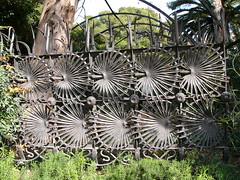
We did manage to do some sightseeing in Barcelona. We saw the Sagrada Familia - designed by Gaudi. Has been under construction for over 100 years and is still nowhere near finished. We went to Guell Park - gardens and buildings and architecture designed by Gaudi. And we went to the Gaudi Museum. At first glance I found the Gaudi architecture ugly and, well, gaudy. But after really looking at it you begin to see the naturalistic elements, the themes and the allegories to nature. The columns that soar up to the ceiling and twist & turn like trees. The palm fronds that make up gates & fences. The real live palms planted next to the stone palm trees that support the walkways. I like Gaudi's work.
So after 48 hours in Spain, I conclude that I like the weather but I don't like Barcelona very much. It is too, too crowded and too focussed on ripping off the tourists. Too many people wanting money for nothing. I admit that two days is not enough time to get a feel for an entire country, and I'm not judging Spain based on my time in Barcelona. There is so much there that we haven't seen. But on this trip we only had time to visit one place. Now it's off to Italy, via the south of France.
France
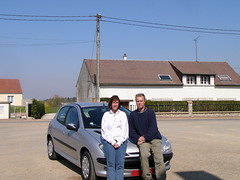
After we left Paris Peter and I spent five days driving through rural France. We picked up our Peugeot 206 from the airport last Monday morning. We arranged the Peugeot Eurolease before we left New Zealand which means we have effectively bought this car (brand new), and then we will sell it back to Peugeot when we leave in three and a half weeks from now. It is small (which is very handy in Europe) and gutless, but it fits us and all our stuff in easily. It has also turned into a bit of a traveling pantry as we have certainly taken the opportunity to be able to make our own breakfasts and lunches to cut down on expenses somewhat.
The first day we drove from Paris to the Loire Valley. Not very far in terms of distance, but it took us at least an hour to maneuver around Paris from CDG in the north east, to heading in a south west direction. That was once we figured out where we were, as our map of France (that we picked up at the Auckland travel expo last month :) ) was not particularly detailed.
We decided that on this trip we would go camping to keep costs down. We brought our tent and sleeping bags with us from New Zealand. After the freezing cold weather in both London and Paris, we were beginning to regret that decision. But we found the temperature in the Loire to be warmer than the cities, and the campsite at the small town of Onzain was open year round and not very crowded at all. Although after a week of camping now I can say that I’ve seen only one other person in a tent – everyone else is in caravans and campervans. It has worked out well for us and hasn’t really been that cold. Getting up in the morning is the hardest part as you have to get out of your warm sleeping bag.
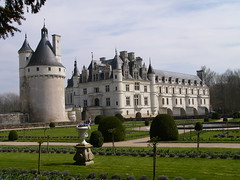
We spent one full day in the Loire Valley, visiting several chateaux, and one winery. There are vineyards everywhere and loads of them have wine tasting (degustation). But it’s difficult when you don’t really know the customs – I feel uncomfortable enough in NZ when you go to a vineyard and don’t buy any wine. So we only went to one place, and that was the one recommended by the manager of the campsite. Bought two bottles, a red and a white, and it came to only 10 Euros (NZ$20). Not bad prices. Found out later that you can buy wine in the supermarkets for as little as 2 Euros!
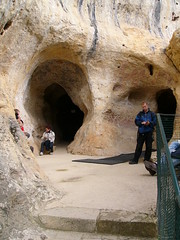
Wednesday we drove to the Dordogne (Perigord) region, which is full of cave systems where prehistoric man lived, and is also the foie gras capital of France. We visited several caves on Thursday and were actually able to see real 14,000 year old cave paintings. It was pretty incredible. They only let a couple of hundred people in a day to see the real paintings, and group sizes are strictly limited. I’ve found one of the benefits of traveling outside of the peak season is the lack of queues everywhere, and in this case we were lucky enough to be able to see the caves the same day and didn’t have to book in advance. They are just outside the little town of Les Eyzies, which in itself is pretty spectacular with not just prehistoric man living in the cliffs, but also with modern houses built half way up the cliff face. But it’s also a bit of a touristy town so we didn’t spend much time there. Also went and saw reproductions of the famous cave paintings at Lascaux. The originals are off limits to the public now as they were becoming badly damaged by the presence of people.
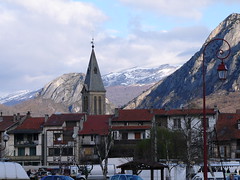
Friday night we camped in the town of Tarascon in the foothills of the Pyrenees mountains. It is a very beautiful little town, and the mountains still have snow on their peaks. In winter I imagine Tarascon is blanketed in snow, but at this time of year the snow line is far higher. The river that runs through town looks quite full of icy mountain water. This was the only time I’ve really found it cold since we left Paris.
Saturday morning we left France (temporarily) and drove to Spain. But that’s another story…
I have really enjoyed France, and especially getting somewhat off the beaten track and into villages instead of cities. The people we have met have all been friendly, even though our French is very limited. It is getting easier to understand people, especially if the French word sounds like the English version. The guided cave tour we went on was in French only, but we were able to pick up the gist of what was being said, even if we didn’t really understand all of it.
To those people who laughed at us trying to learn French before we left home, and who said “everyone speaks English”, you are wrong. Most people when we ask “parlez Anglais?” reply either “non” or “a leetle”. Maybe they’re just saying that, but they are all genuinely helpful and we have managed to get by on the little bit of French that we know, and with hand gestures.
We have gone out for dinner most nights, endeavouring to sample the local delicacies – sausisson (spicy sausages), canard (duck), local fish, endives and other veges, and local wines. I even gave in to curiousity and sampled the foie gras. I though it tasted pretty horrible really and can’t see why it’s such delicacy. Still haven’t managed to try escargot yet.
We will be back in France again soon, for three or four days, as we travel across the south to Italy…
 We stayed in the small town of Remoulin, just east of Nimes, and right next to the Pont du Gard, an amazingly well preserved, totally intact, three level Roman aqueduct spanning the river Gard. For free we were able to walk right up to it, touch it, walk around it, view it from every angle, do everything but walk across the top.
We stayed in the small town of Remoulin, just east of Nimes, and right next to the Pont du Gard, an amazingly well preserved, totally intact, three level Roman aqueduct spanning the river Gard. For free we were able to walk right up to it, touch it, walk around it, view it from every angle, do everything but walk across the top. In Nimes we saw an old Roman colosseum which is still used for sporting events to this day, and an ancient Roman temple (now called the Maison Caree - square house) which is also perfectly preserved due to having been continuously used throughout the centuries.
In Nimes we saw an old Roman colosseum which is still used for sporting events to this day, and an ancient Roman temple (now called the Maison Caree - square house) which is also perfectly preserved due to having been continuously used throughout the centuries. One hidden treasure we did find in Cagnes-sur-Mer was the house that Renoir (my favourite artist) had built, and where he lived and worked for the last 11 or 12 years of his life. It has now been turned into a museum dedicated to the artist. Really incredible to see his actual studio and to learn a bit about his life.
One hidden treasure we did find in Cagnes-sur-Mer was the house that Renoir (my favourite artist) had built, and where he lived and worked for the last 11 or 12 years of his life. It has now been turned into a museum dedicated to the artist. Really incredible to see his actual studio and to learn a bit about his life.




